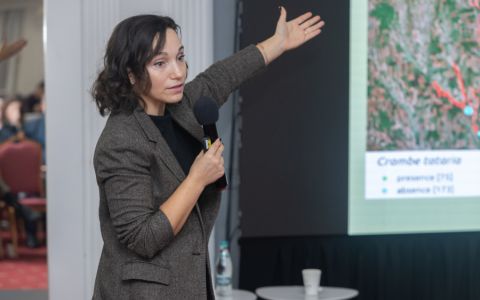Ecological organization Arnika has published lists of consumables packed into PVC. A survey done in Děčín´s supermarkets disclosed more than 60 of such kind. And at the same time PVC is infamous as a high-risk material harming health and the environment. That is why Arnika has launched today the poster campaign in Děčín´s public transport, which warns consumers against this plastic. The main motif of the poster is a little duck made of PVC, containing, despite its innocent look, detrimental substances.
„This cute little duck is not any angel, it is made of PVC!“ anounces the first from the series of posters. „Through the campaign we want to show, that PVC is dangerous not only in children toys or sanitary products. Detrimental substances are already created during the production of polyvinylchloride and very problematic is also its recycling. We also want the public to get acquainted with how to differentiate PVC from other plastics. That is why we put symbols according to which people can identify products or packages made of PVC on the posters,“ said head of the campaign Do Not Play with PVC Ing. Miroslava Jopková.The poster campaign in Děčín will last until May. There will be three variants of posters with ducks in public transport areas.
„Packing food into polyvinylchloride is very risky. In many studies it was found that consumables were contaminated by releasing of phtalates and adipates from PVC packings. Some of these substances can be harmful to reproduction and hormonal system. They are predominantly dangerous for small children,“ points out Jopková. „We found in PVC packing various kinds of meat products, spreads, also a dairy product called Termix or cakes made of ice-creams,“ added one of organizers of the survey and head of Arnika in Děčín, Kamil Repeš. Food packages made of polvinylchloride can have many forms. We can see all kinds of small bathinettes, pots or shrink-wraps, some lables are also problematic.
Way of liquidation of PVC packagings indirectly influences quality of food. „During liquidation of PVC in landfills or incinerators, toxic substances, including heavy metals or dioxins, are released and can very easily penetrate into the food chain ending with man,“ said Jopková. Dioxins due to presence of PVC are created not only in incinerators of wastes, but also during fires of waste landfills.
Arnika´s activities in this project were supported by grant provided by Iceland, Lichtenstein, Norway and by the EEC Financial Mechanism and Norwegian Financial Mechanism by NROS (Foundation for Development of Civil Society) and by grant of the Prague City Hall.
PVC itself is not a material to sort. If mixed with other plastics, it creates problems. For example Pet bottles are processed in lines, then these plastics are crushed and by dissolving separate particular types of plastic. Polyethylene and polypropylene are lighter than PET and flow, PVC as well as PET sink to the bottom and it is not possible to separate them by this way. So in case PVC gets anyhow among PET ( as a label, for instance), depreciates valuable raw material. Internet sources state that only one bottel made of PVC depreciates from 33 to 50 thousand PET bottles.
Packages made of PVC are marked by triangular recycling symbol with figure „3“ or letter „v“. Below the triangle there is a sign „PVC“, „V“ or „vinyl“. This symbol is usually on the bottom side of the product or on the paper label.
Concentration of dioxins in emission depending on the concentration of PVC in the burnt material.
Concentration of PVC in burnt material 0% 0,2% 1% 7,5%
Concentration of dioxins in emission Average ng I-TEQ/kg fuel 14 80 200 4900
Range in ng I-TEQ/kg fuel 2 - 28 9 - 150 180 - 240 3500 - 6700
An overview of fires at waste landfills in the region of Ústí nad Labem (There was a possibility of dioxins release into the air due to presence of PVC in wastes)
14. - 15. 7. 2005 – fire at the waste landfill in Tušimice
5. 2. 2006 a 14. - 24. 2. 2006 – repeated fire of German communal waste brought in illegally in silos in Libčeves in the region of Louny, rests of the ashehs were after analysis classified as detrimental waste.
9. - 11. 3. 2006 – Rests of foam and another plastic parts used as arm and headrests fillers in cars were burning at the waste landfill in Tušimice on the area of 30 x 40 m.
16. - 21. 4. 2006 – Fire of German wastes in Libčeves. Rests and ashes were on May 8th brought back partly to Germany and partly, first to the landfill Celio by Litvínov, from where it is supposed to be carried back to Germany.
12. - 22. 7. 2006 – Waste landfill Celio by Litvínov repeatedly on fire in the region of Most.






